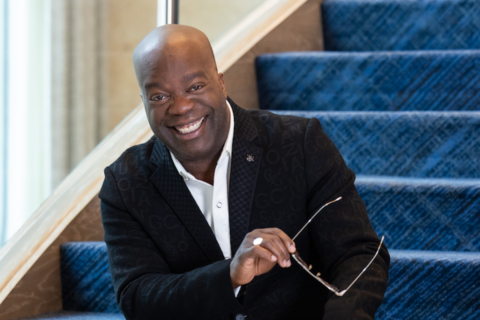Conversations happen in the workplace all the time. Problem is, most of them don’t get us anywhere. Coworker small talk aside, many workplace conversations are really just two people having their own separate monologues. Or they’re “check-the-box” meetings contrived to get pre-ordained results. Or they may be “competitions” where one person emerges a winner (or at best agrees to meet someone halfway in a kind of tepid compromise).
Ed Hess says we can do better. In fact, as the digital age surges on, we’ll have to if we’re to stay agile and relevant in a marketplace defined by flux, accelerating levels of chaos, and the relentless march of smart technology, especially AI.
Cultivating workplace conversations
“As skill sets become increasingly specialized and business gets more complex, it will take multiple people working together to quickly problem-solve, innovate, and do all the other tasks technology can’t,” notes Hess, author of Hyper-Learning: How to Adapt to the Speed of Change. “All of that must happen through the right kind of conversations.”

Hess says the conversations that should predominate in today’s business world are those where each person is a) striving to be understood by the other, and b) trying to understand the other. He calls these “High-Quality, Making-Meaning Conversations.” He notes that such conversations—which must occur in a caring, trusting, noncompetitive setting—serve several purposes. They help us:
- meet our innate needs for social connection and belonging to a group.
- validate our uniqueness and humanity.
- build caring, trusting relationships with others.
- learn, unlearn, and relearn…over and over again (a skill Hess calls “Hyper-Learning”). This is a vitally important outcome of conversations, since we are all suboptimal learners who are ego-driven and have a hard time letting go of our beliefs.
- unpack underlying beliefs, assumptions, facts, lack of facts, and differences and achieve critical thinking in the spirit of an idea meritocracy.
- pursue and achieve creativity, imagination, innovation, sense-making, or emergent thinking.
If such conversations regularly happen at your company, it says good things about your culture. It suggests that you’re an idea meritocracy, and that you embrace the principles of positivity, psychological safety, and self-determination.
Most likely, people bring their “Best Selves” to work and maintain the inner peace needed to mitigate the two big learning inhibitors: fear and ego. These are the kinds of cultures that allow companies to thrive in a rapidly changing world.
Create a thriving culture through conversation
The good news is there are things you can do to make it more likely that these kinds of conversations will unfold. For instance:
Set the right preconditions for the conversation
Hess says it helps if everyone arrives at the meeting in a state of positivity and inner peace. But even if not, there are things leaders can do to make meetings go well. They can explain the purpose of the meeting, ask everyone to agree on common values, and spell out the rules of engagement: for example, candor; open-mindedness; listening to learn, not to confirm; saying “yes, and” instead of “yes, but”; and so forth.
“Plus, if it’s a new team, it can be helpful to allow time up front for people to introduce themselves and learn a little about each other,” he adds. “Explain to them that you hope this is the beginning of a Caring, Trusting Team—that this is your ultimate goal.”
Make sure all parties respect each other and uphold each other’s human dignity. People vary quite a lot in what they find emotionally hurtful. Some are very sensitive to the slightest perceived insult even if it is unintentional. It’s better to err on the side of respecting the dignity of each person.
It doesn’t matter that you do not think your words or behavior are hurtful. Never critique the person; critique the idea and do so in a manner that increases the probability that the other person actually hears you. Say something positive—start out with what you agree with. Then offer your differing views in a calm, non-personal manner, setting forth your data.
Prioritize asking over telling (and learn the fine art of sharing)
The best High-Quality, Making-Meaning Conversations happen when people ask questions and when they reflectively listen (more on this later). Telling sends the message that I know more than you. Telling is a power play. Sometimes, of course, you have to explain your position—but Hess says this still doesn’t require telling. Rather, it requires sharing.
“When you share, you should make it explicit that you are sharing and not expressing certainty,” he explains. “When you disagree with someone, you should first explain the points on which you agree. Then you can share your questions, concerns, or disagreements. Sharing the positive first helps tamp down defensiveness. I’ve found it helpful when I disagree or have concerns to say, ‘Here is my hypothesis,’ not, ‘Here is what I believe.’”
Ask additional questions
Remember that the purpose of work conversations is to learn. Learning requires lots of questioning. Here are just a few questions Hess recommends asking (depending on the purpose of the conversation, of course):
- What are our differences?
- What are we missing?
- What assumptions are we making? Have we unpacked them to see what underlies them?
- How can we reframe this discussion or problem?
- Have we looked for disconfirming information?
- Is everybody okay?
- Does anyone have a different way of looking at this?
- Who might have had this challenge or problem already? Have we looked there for learnings?
- Have we visualized the outcome if we do this?
- Have we visualized how the outcome can be a failure?
Practice reflective listening
This requires a quiet ego, quiet mind, quiet body, and positive emotional state. Remember, we are wired to be speedy thinkers who seek confirmation and affirmation. We tend to let our minds wander or begin making up our response while the other person is still talking. We may even multitask with our devices or even interrupt the person who is talking. Reflective listening is the opposite. It requires us to demonstrate that we truly are listening and trying to understand what the other person is saying.
The best way to do that is to first paraphrase and restate the words and feelings of the person who is speaking and ask if you are correct in your understanding of what he or she said. You might also say, “I want to make sure I understand what you are saying. Did you mean this?” Demonstrating that you really listened before advocating your position evidences that you care about the person and his or her views. That can help build trust—the foundational building block for having High-Quality, Making-Meaning Conversations.
Hess says High-Quality, Making-Meaning Conversations can lead to that magical sense of collective flow, where all team members are “in the zone” and primed for Hyper-Learning.
Conversations cultivate creativity and innovation
“When we hold the right kinds of conversations, we find they are the gateway to the highest levels of creativity and innovation, emotional engagement, and higher-order critical thinking,” says Hess. “They literally allow us to leave our egos and fears at the door, tolerate uncertainty, and not only trust others but trust ourselves—the more liberated, peaceful versions of ourselves.”
Edward D. Hess is professor of business administration, Batten Fellow, and Batten Executive-in-Residence at the Darden School of Business and the author of Hyper-Learning: How to Adapt to the Speed of Change. Professor Hess spent 20 years in the business world as a senior executive and has spent the last 18 years in academia. He is the author of 13 books, over 140 articles, and 60 Darden case studies. His work has appeared in over 400 global media outlets including Fortune, European Business Review, HBR, SHRM, Fast Company, WIRED, Forbes, Inc., Huffington Post, Washington Post, Business Week, Financial Times, CNBC Squawk Box, Fox Business News with Maria Bartiroma, Big Think, WSJ Radio, Bloomberg Radio with Kathleen Hays, Dow Jones Radio, MSNBC Radio, Business Insider, and Wharton Radio. His recent books and research have focused on Human Excellence in the Digital Age: A New Way of Being; A New Way of Working; Humanizing the Workplace; and Hyper-Learning. For more information, please visit edhess.org.
© YFS Magazine. All Rights Reserved. Copying prohibited. All material is protected by U.S. and international copyright laws. Unauthorized reproduction or distribution of this material is prohibited. Sharing of this material under Attribution-NonCommercial-NoDerivatives 4.0 International terms, listed here, is permitted.








